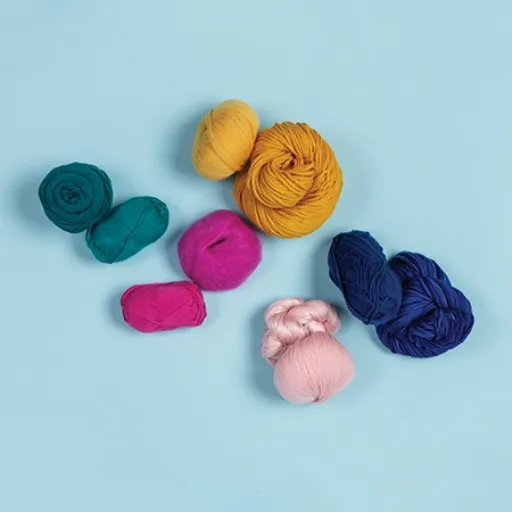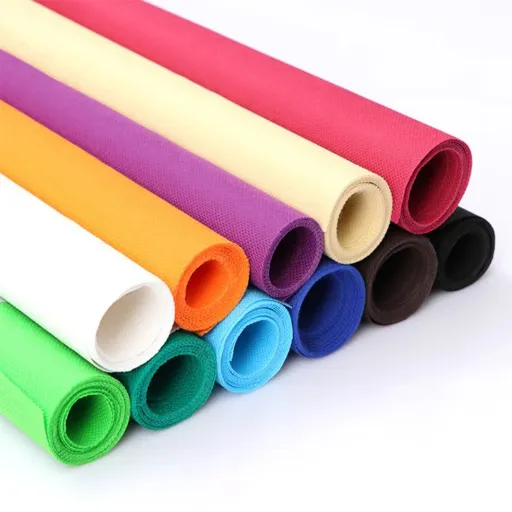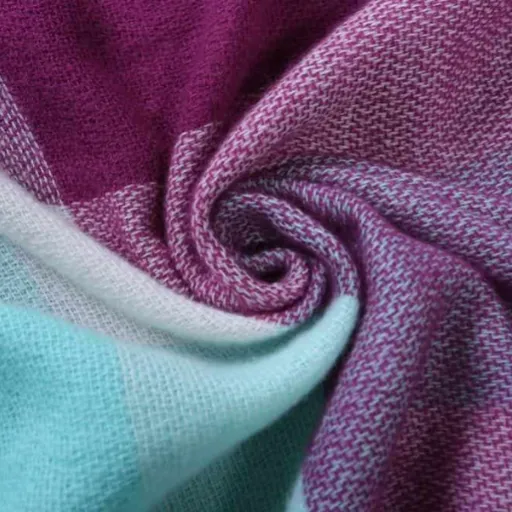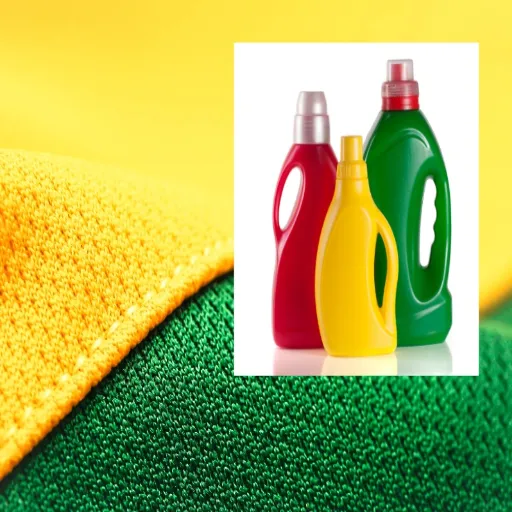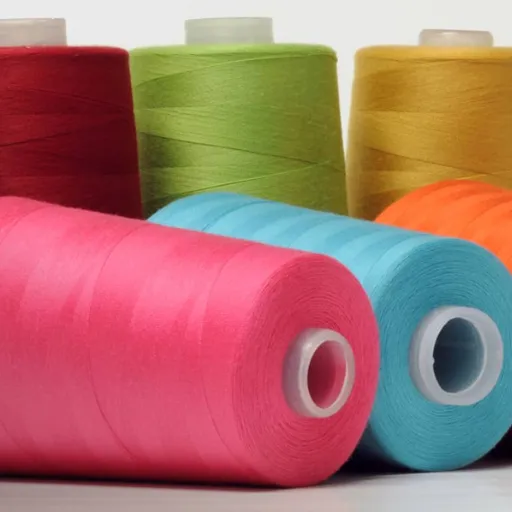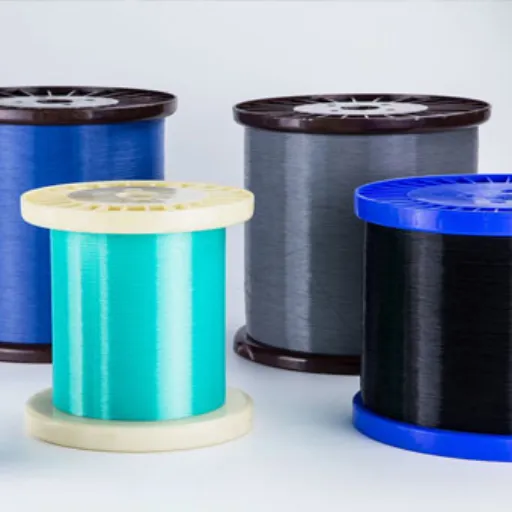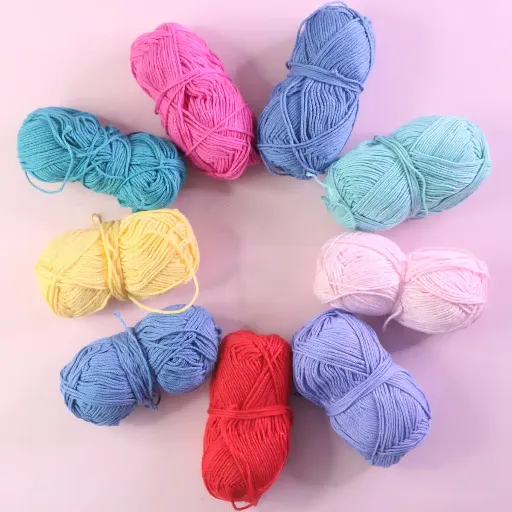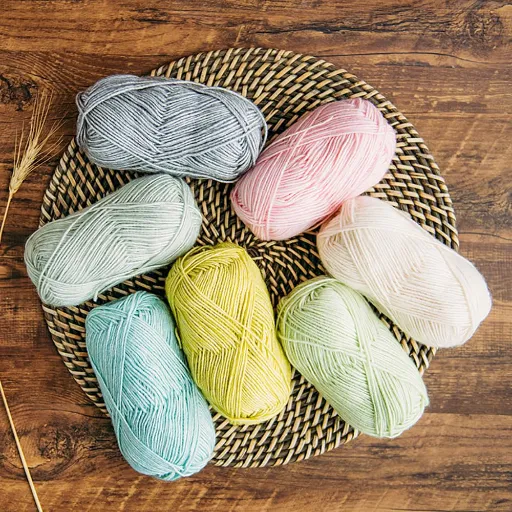Choosing yarn is rarely a casual decision for a crafter; longevity tends to sit at the top of the checklist whenever a new blanket or sweater is imagined. Many makers keep returning to acrylic because it holds color beautifully, asks for almost no upkeep, and costs a fraction of what wool or silk would. However, the marketplace is flooded with skeins claiming toughness, so spotting one that endures weekly use without losing its softness can feel like searching for a needle in a haystack. This brief overview cuts through the clutter. It pinpoints the strands that won’t sag, bleed, or fray at the first wash while still laying flat against the skin. Included are the telltale labels, yardage estimates, and pro shortcuts that turn a lopsided first attempt into a finished piece you won’t mind showing off.
What Is The Best Durable Acrylic Yarn For Knitting And Crocheting?
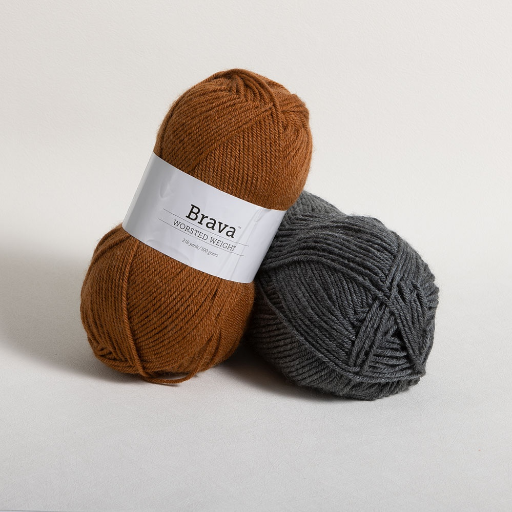
When durability is the main concern, Lion Brand Vanna’s Choice regularly ranks at or near the top of many recommendation lists. Its medium weight and smooth hand resist pilling over time, a feat not all acrylics achieve. After repeated machine laundering, the yarn still feels soft and the finished piece retains its shape. Because fade-resistant pigments are factory-dyed into every strand, projects centered on colorwork do not look washed out after the first few cycles.
Top choices for durable acrylic yarn
In side-by-side testing, Red Heart Super Saver also held up nicely. Craftspeople single out the spool for its affordability and low maintenance-care-anything that can survive the tumble dryer earns a thumbs-up for everyday blankets. While the weight and ply differ slightly from the Lion Brand product, both yarns share the same dependable, long-lasting quality makers often list as their top priority.
Caron One Pound is frequently cited as a workhorse yarn, and for good reason. An entire pound per skein yields enough yardage to tackle an oversized afghan or a long-sleeve sweater with yarn left over. The textured plies lock together so evenly that even beginner knitters watch their stitches fall into crisp, visible lines. Launder the finished piece half a dozen times and it still comes out plush rather than prickly.
Bernat Premium speaks to makers who think twice about the materials they choose. . The fibers are twisted closely enough to shrug off snags, yet the finished fabric feels forgiving against a sleeping babys cheek. Sweaters, winter scarves, and the ever-generous baby blanket slip off the needles without fuss. It sits on store shelves at a price almost any hobbyist can live with, so professionals grab it without hesitation.
Comparing yarn durability for various projects
|
Yarn Type |
Durability Rating |
Best for Projects |
Washability |
Cost Efficiency |
Special Features |
|---|---|---|---|---|---|
|
Acrylic Yarn |
High |
Blankets, scarves, hats |
Machine washable |
Affordable |
Wide color variety |
|
Medium |
Dishcloths, summer garments |
Easy to wash |
Moderate |
Breathable and lightweight |
|
|
High |
Winter wear, sweaters, socks |
Often hand wash only |
Expensive |
Warm and stretchable |
|
|
High |
Luxury items, scarves, sweaters |
Hand wash preferred |
Premium |
Soft and hypoallergenic |
|
|
Very High |
Rugs, bags, durable accessories |
Machine washable |
Affordable |
Strong and resilient |
|
|
Bamboo Yarn |
Medium |
Eco-friendly, summer garments |
Hand wash preferred |
Premium |
Silky finish and soft touch |
|
Nylon Blends |
Very High |
Durable socks, outerwear |
Machine washable |
Cost-effective |
Elastic and durable |
|
Silk Yarn |
Moderate |
Luxury garments, shawls, lingerie |
Delicate wash |
Expensive |
Lustrous and elegant feel |
|
Linen Yarn |
Medium |
Summer tunics, table runners |
Hand wash preferred |
Moderate |
Durable and strong texture |
What makes acrylic yarn a durable option?
Acrylic yarn earns a reputation for durability largely because it is made from synthetic polymers that shrug off moisture, mildew, and ordinary wear. By contrast, wool or cotton often shrinks and fades when the weather turns humid or wet, leaving the acrylic version looking and feeling intact. Shapability remains one of the material’s strongest selling points; garments and blankets keep their fit even after months of washing. Manufacturers have lately upgraded spinning and finishing processes to boost tensile strength, so the yarn is far less likely to stretch out or snap under tension. Combined, these traits let crafters and manufacturers pick acrylic when long life and low fuss are non-negotiable.
How To Choose The Right Yarn For Your Projects?
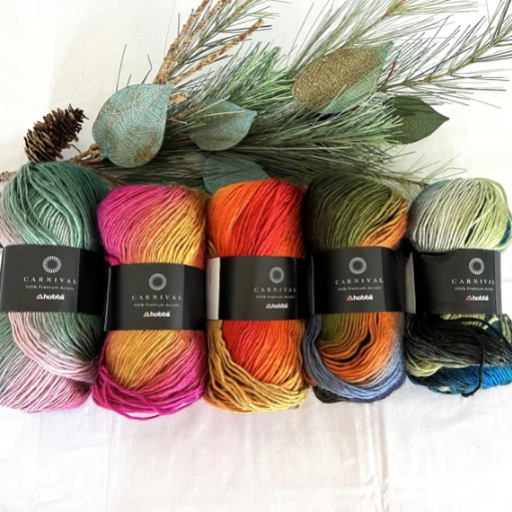
1. Project Type-idiously specific project in hand. Delicate shawls and baby onesies often insist on soft, breezy yarns such as cotton, silk or fine merino; on the other end, those winter blankets lean toward robust skeins of acrylic or chunky wool that can shrug off everyday abuse.
2. Weight & Thickness-every pattern leaves a hint about weight-lace for drape, worsted for balance, bulky for sheer heft. Stick to that hint and the finished piece will sit exactly where you intended.
3. Fiber Composition-choose fibers by mood rather than impulse. Soft alpaca or crisp linen breathe beautifully but demand ritual washing, while spunky nylon or coated acrylic laugh at the grime and tolerate the dryer.
4. Budget-project calculator in hand, crunch the yardage then scour the shelves. A smart shopper finds a blend that feels satisfying without emptying a bank account.
5. Color and Aesthetics- pick threads that match the story you’re telling. A matte peach may whisper elegance, whereas a variegated teal could shout for attention.
Always check the yarn label for care instructions and gauge information to ensure compatibility with your needs and tools. Swatching before starting can also help test its suitability.
Factors to consider when selecting yarn
- Fiber Content: The precise material in a skein wool, cotton, acrylic, or silk plays a pivotal role in the feel, longevity, and usefulness of the finished knit. Soft wool traps warmth yet stretches back into shape; airy cotton keeps summer accessories cool against the skin. Always select a fiber in harmony with the comfort and performance you want the item to deliver.
- Weight and Ply: Yarns are graded from whisper-light lace to hulking super bulky, and that measurement sets the scale of the whole project. Heft influences whether a shawl drapes gossamer-thin or a blanket coils like a castle wall. Ply, or the number of individual strands twisted together, further steers the strand’s resilience and its springy give when worn.
- Durability and Maintenance: Think about how the piece will stack up to everyday life. Heavily used linens or sock yarns need fibers that shrug off abrasion and survive the spin cycle without falling apart. A machine-friendly blend saves time; finer or vintage materials often demand slow hand-washing to keep them in working order.
- Environmental Impact: Sustainable yarns often spun from certified organic fibers or reclaimed fabrics are now at the forefront of conversations about responsible crafting. When selecting a strand, be mindful of the emissions, water usage, and chemical runoff generated from farm to factory, especially if the principle of sustainability resonates with your work.
- Allergies and Sensitivities: Not everyone can wear the same skein; itchy reactions often accompany animal-based fibers like wool, alpaca, or mohair. To keep projects inclusive, many crafters lean on super-soft botanicals such as bamboo, or on synthetics like acrylic that stop irritation at the skin-line.
Comparing acrylic yarn with cotton and wool yarn
|
Key Point |
Acrylic Yarn |
Cotton Yarn |
Wool Yarn |
|---|---|---|---|
|
Source |
Synthetic, petroleum-based fibers |
Natural, derived from cotton plants |
Natural, derived from sheep fleece |
|
Softness |
Varies, often soft but not natural |
Soft and breathable |
Soft and naturally warm |
|
Durability |
Highly durable, resistant to wear |
Moderately durable |
Durable, but prone to pilling |
|
Moisture Absorption |
Low moisture absorption, dries fast |
Absorbent, but slower to dry |
Absorbent, moisture-wicking |
|
Warmth |
Provides moderate warmth |
Light warmth, breathable |
Excellent warmth, suitable for cold climates |
|
Maintenance |
Easy, generally machine washable |
Easy, but may shrink in hot water |
Requires special care, gentle washing |
|
Cost |
Generally affordable |
Affordable to mid-range |
Expensive, varies by type |
|
Environmental Impact |
High, non-biodegradable |
Biodegradable, but water-intensive |
Biodegradable, sustainable with ethical sourcing |
|
Allergy Potential |
Low risk of causing allergies |
Low, natural, skin-friendly |
Higher risk for wool sensitivities |
|
Texture Variety |
Wide variety, versatile applications |
Limited texture options |
Wide variety, rich texture options |
Understanding yarn weight and its impact on durability
Yarn weight lies at the heart of any knitting or crochet study, since it determines how thick, sturdy, or airy a finished piece will be. Bulky lines grow into hefty textiles that shrug off scuffs and last for seasons, so they appear in rugs and winter coats. Lace or fingering strands, by contrast, yield a feather-light web perfect for moth-wing shawls or pieces where drape must outscore ruggedness. Stitch tension and fiber blend step in next, because taut loops tighten a lightweight fabric while loose ones invite stretch and snag. A crafter who matches loft, fiber, and finished use writes longevity into the project from the start.
What Are The Benefits of Using Durable Acrylic Yarn?
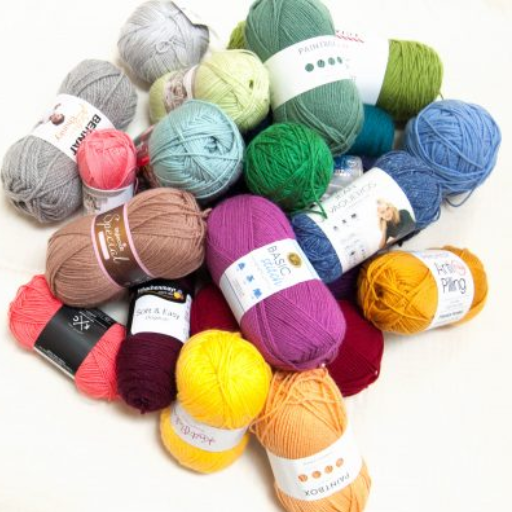
- Cost-Effectiveness: Acrylic yarn is typically more affordable than natural fibers, making it an economical option for large or frequent projects.
- Low Maintenance: Acrylic offers a second, and quieter, advantage in its wash-and-wear ease. Toss it into a machine, skip the softening cycle, and colors hold fast while the yarn shrinks barely, if at all. That resilience makes the fiber a go-to for baby blankets, everyday sweaters, and any piece expected to face repeated cycles of dirt and detergent.
- Versatility: Acrylic yarn arrives in a nearly bewildering palette of colors, textures, and weights. Designers can pair a glossy worsted with an ombré chunky strand and never miss a beat.
- Durability: Because acrylic is first-and-foremost synthetic, abrasion sits back and lets the fiber do its work. Projects endure routine use without the fuzzy halo that sometimes claims wool or cotton.
Those seasoned with needles and those still learning alike tend to reach for acrylic, if only for the quiet promise that the strand will behave and last.
Affordability and accessibility of acrylic yarn
Price point matters, and acrylic usually sits near the bottom end of the spectrum. Factories can dial up production faster than any sheep can grow a fleece, so the market stays flush. When a crafter can haul home six skeins for the cost of a single ball of hand-spun merino, hesitation evaporates. Add in the fact that every drugstore and box store carries the stuff, and the lure becomes almost irresistible. Economical, omnipresent, and surprisingly resilient, acrylic yarn often plays the role of humble hero in the makers pantry.
Machine washable and easy to care for
People gravitate toward acrylic yarn partly because it demands so little attention once the last stitch is in place. Blankets, winter cardigans, and casual scarves can all be tossed into a washing machine without a second thought, and the yarn will not shrink the way many wool or cotton blends will. A gentle cycle with a mild detergent usually suffices, and the material dries swiftly on a low-heat tumble cycle-or even just draped over a chair if patience allows. Craftspeople appreciate that projects keep the look and feel they had on day one, a small but noticeable victory over other fibers. In recent years manufacturers have refined the filament, boosting its ability to shrug off pilling and resist fading under sunlight or repeated wear. Because of these durable, low-maintenance traits, acrylic yarn remains a workhorse choice for hobbyists and small-scale apparel makers alike.
How Does Acrylic Yarn Compare To Natural Fibers?
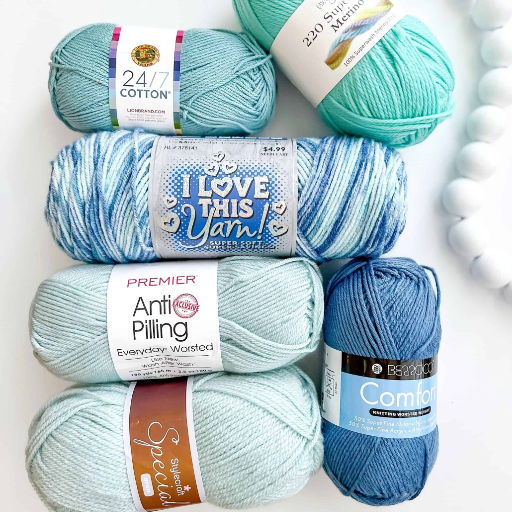
Acrylic yarn is made by polymerizing small molecules into long chains, a synthetic process that sets it apart from plant- and animal-based fibers. Because the production scale is enormous, the finished yarn usually costs much less than cotton or cashmere. Crafters appreciate the weight-to-warmth ratio, since the filament stays light yet resists both fading and pilling for the life of the piece. Long-term exposure to moisture was once a liability for untreated acrylic, though modern finishes have closed that gap pretty well. On the comfort side, no chemical fiber quite matches the breathability or natural softness of spun wool or linen. Washing is another divide: a ball of acrylic tumbles through the machine without a second thought, while many animal and plant blends demand gentler treatment. In the end, deciding which material to use comes down to balancing budget, upkeep, and the tactile feel the finished item must deliver.
Durability of synthetic versus natural fibers
Acrylic, polyester, and nylon-polymeric threads born of chemical halls rather than grazing pastures usually overpower their organic rivals when it comes to sheer toughness. Their synthetic backbone resists ripping, stretching, and even the slow erosion sunlight and moisture conspire to inflict. Take polyester: cloth woven from that single filament keeps its shape and tensile strength through marathon practice, three-season commutes, and countless turns in an indifferent washing machine. In contrast, cotton, wool, and silk cater to comfort and drape yet unravel or thin out faster the moment they meet a rough edge or persistent damp. A wool garment may still pill or felt after one evening spent rubbing against a purse strap. Coatings, enzyme washes, and the hybrid blends assembly line designers love do push natural fibers farther into the durability zone, yet spandex-steepled activewear and canvas-back camping gear still rely on the built-in stamina of engineered yarns.
When to choose acrylic over cotton or wool yarn
Durability, price, and easy care often steer a crafter toward acrylic yarn rather than cotton or animal fibers. That synthetic twist holds up to abrasions and daily wear, turning blankets, hats, and kids clothes into survivors rather than one-season wonders. The colorfastness of acrylic is almost legendary; reds, aquas, or pastel yellows stay true through sunlight, soap, and the occasional late-night laundry mishap. Unlike wool, which can shrink or stiffen after an unpredictable tumble through heat or cold water, acrylic simply eases back into shape. People who itch at the thought of sheep fiber appreciate that the man-made strand feels warm without triggering allergies. It dries faster than most natural materials, so an accidentally sodden scarf or dishcloth wont linger for hours. Finally, the economic side can’t be ignored; crafters who are scaling up a community project find they can stretch dollars further without sacrificing strength or comfort.
What Are Some Popular Projects Using Durable Acrylic Yarn?
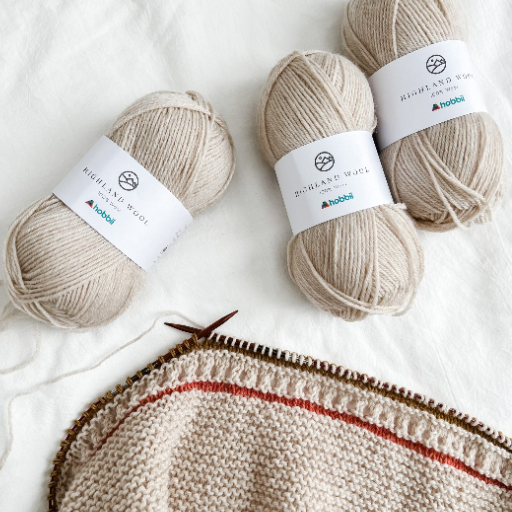
Acrylic yarn is widely used in projects that require durability, ease of care, and affordability. Popular projects include:
- Blankets and Afghans: Blankets and afghans remain the unofficial flagship project. The fleece-like softness translates quickly into pliable warmth, yet a spin in a standard machine keeps the surface looking fresh.
- Sweaters and Scarves: When the stitch count turns toward sweaters or scarves, the yarn behaves like a featherweight insulator. Knitted fabric holds body heat without pushing the wearer into overheating.
- Hats and Gloves: Hats and gloves rely on another trait: inherent stretch. Even after being pulled on and off a dozen times, ribbing rows snap back.
- Home Décor Items: Home decor is where the bright shade chart shines. Cushion covers, plant pot toppers, or even a wall fringe announce color without fading to mush.
- Toys and Amigurumi: Amigurumi enthusiasts appreciate the same resilience in stuffed animals. The fiber bends into shape but refuses to sag under small hands.
All these characteristics line up to explain the yarns popularity with novices who want quick results and with seasoned artisans chasing consistent output. Versatility alone would be enough to keep a ball of acrylic in almost every studio.
Creating cozy blankets and garments
Crafters reach for acrylic yarn when the goal is a blanket that feels warm without weighing a ton, and still doesn’t empty the wallet. Because the fiber is synthetic, any spill can usually disappear in a wash-and-dry cycle, a trusted routine for busy households. Production upgrades some born in textile labs, others honed on factory floors have quietly closed the softness gap between acrylic and classic wool. Go into a craft shop and the shelves boast every imaginable shade and ply, so a designer can match a room’s trim or a toddler’s favorite toy on the same outing. Test labs confirm what makers have sensed for years: the yarn laughs off pilling, keeps its bounce, and looks good after seasons of wear. Parents and pet-owners value it, too, because the hypoallergenic blend delivers dependable warmth without triggering itchy surprises.
Knitting and crocheting scarves and sweaters
Knitting or crocheting a scarf or sweater is part craft and part expression; the finished piece must keep its wearer warm, present a certain look, and hold together after multiple washes. Most makers begin by reaching for a skein and weighing how heavy, how warm, and how soft they really want the fabric to feel. Beginners often stay with light worsted yarn when creating simple sweaters because the thickness is neither too flimsy nor oversized. Scarves, by contrast, handle lighter fingering or sport-weight skeins well since extra drape lets fans of lace show off open motifs while the piece still behaves as a real garment.
Blush-colored acrylic, heather-blue wool-blend, or glacier-green alpaca each tell a slightly different story, yet they all end up in the same basket of home-knitting supplies. Acrylic yarns resist fading, shrug off stains, and survive tumble-dryer heat, so they win hands-down when children or pets share the sofa. Merino or alpaca feels cool in summer and cozy in winter, quietly balancing humidity while brushing the skin in that almost buttery manner. Pattern-hunters never stop experimenting row upon row of hide-and-seek bobbles, Tunisian crisscrosses, or Scandinavian color work so the craft never gets stale even after a dozen pullovers. More makers now look for FSC-certified cotton, plant-dyed yarns, or mills that reclaim short fibers because buying beautiful fleece should’t tip the planet out of kilter.
Reference Sources
-
Preparation of acrylic yarns with durable structural colors based on stable photonic crystals
This study focuses on creating flexible acrylic yarns with vivid structural colors using photonic crystals. It addresses challenges like roughness in yarns that hinder regular photonic crystal construction. -
Serviceability and washing durability of recycled polyester, wool, and acrylic: Sustainability concerns and microfiber leaching
This research examines the durability of recycled textiles, including acrylic, and their environmental impact, particularly microfiber leaching during washing. -
Development of non-combustible weaveable yarn through oxidative control of a textile acrylic fibre
This paper explores enhancing the fire-retardancy of acrylic yarns through thermal processing, aiming to improve safety and durability.
Frequently Asked Questions (FAQs)
Q: What is the most durable acrylic yarn for my crochet projects?
A: When looking for durable yarn for crochet projects, consider options like Lion Brand Basic Stitch Premium or Red Heart Soft. These acrylic yarns are known for their strength and are perfect for projects that will experience wear and tear.
Q: Can I use acrylic yarn for my knitting projects?
A: Absolutely! Acrylic yarn is often a popular choice for knitting projects due to its affordability and wide range of colors. Brands like Big Twist Value Yarn offer options that are easy to work with and suitable for both beginners and experienced knitters.
Q: How do I choose the right yarn for home projects?
A: Choosing yarn for home projects requires considering the type of yarn and its durability. Look for premium acrylic yarns that are machine washable and can withstand everyday use, like Lion Brand Basic Stitch Premium. This ensures your projects maintain their quality over time.
Q: What are the benefits of using durable yarn?
A: Durable yarn is crucial for projects that will be subjected to frequent use. It typically holds up well against wear and tear, making it ideal for items like blankets and home decor. Plus, many durable yarns are super soft, providing comfort without sacrificing strength.
Q: Are there budget-friendly options for durable acrylic yarn?
A: Yes, there are several budget yarn reviews available that highlight affordable yet durable options. Brands like Big Twist Value Yarn and Red Heart Soft offer great quality at a lower price point, making them accessible for various yarn projects.
Q: What should I look for when comparing different types of yarn?
A: When comparing different types of yarn, consider the weight of the yarn, its softness, and its durability. The ultimate acrylic yarn comparison will help you find the best fit for your knitting and crochet projects, ensuring you choose a yarn that meets your needs.
Q: Is acrylic yarn machine washable?
A: Yes, most acrylic yarns are machine washable, making them a practical choice for everyday projects. Look for labels that specify machine wash to ensure your finished items are easy to care for.
Q: Why is acrylic yarn often recommended for beginners?
A: Acrylic yarn is often recommended for beginners because it is easy to work with and comes in a wide range of colors. Its affordability and durability also make it a perfect choice for learning various techniques in crochet and knitting projects.
Q: Can I mix acrylic yarn with other fibers like wool?
A: Yes, mixing acrylic and wool can create unique textures and benefits in your projects. The blend offers the softness of wool with the durability of acrylic, enhancing the overall quality and usability of your finished items.








